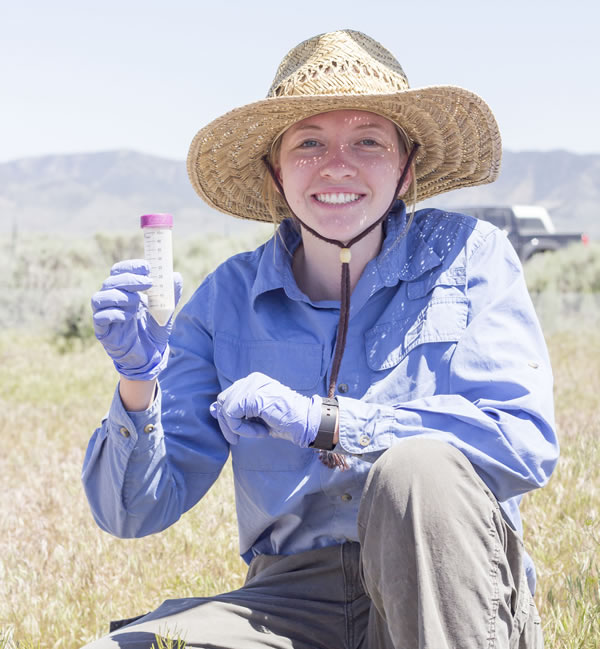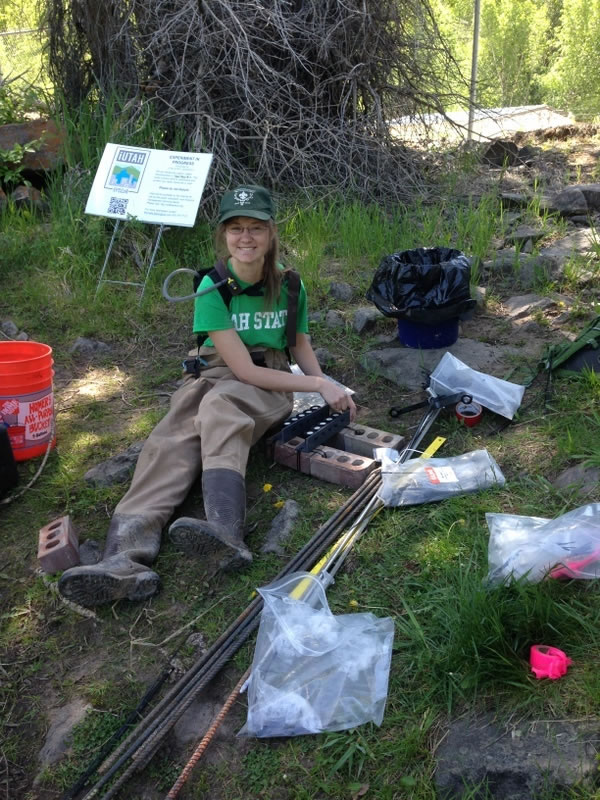Workforce Development News
December 6, 2016
Engaging Neighborhoods in Survey Results
Last summer, nearly 400 people on Salt Lake City’s west side were asked about their connections to the Jordan River and the parklands alongside the river. Bilingual surveys were distributed in public places such as grocery stores, libraries, parks, and community events. Students involved in iUTAH Undergraduate Research Fellows (iFellows) Program, Cynthia Elliott and Luis Vidal, conducted the survey using iPads and interacting directly with residents.
Mark Brunson, professor in Utah State University’s Department of Environment and Society and the USU Ecology Center, and Taya Carothers, PhD student at USU, jointly developed the survey. They were aided in this process by collaborators in Salt Lake City’s open space lands program, Lewis Kogan and Tyler Murdock; and the design consultant for the Three Creeks Confluence project.
“As iUTAH’s director of education, outreach, and diversity, I have long wanted to do something that engaged the diverse neighborhoods on Salt Lake City’s west side and could be used to benefit people in those communities,” said Brunson. The idea for the study started at meeting led by Brian Tonetti, the executive director of the Seven Canyons Trust, held in fall 2015. While talking about how the Glendale neighborhood felt about daylighting (freeing buried rivers and streams) that currently run through Salt Lake City, it became clear that getting input from a broad diversity of neighborhood residents was challenging. This seemed like an opportunity to combine Carothers’s research on environmental justice and water with more general questions that might serve a variety of community projects in the area, such as the Glendale project.
After the survey results were collected and data formulated, iUTAH’s cyberinfrastructure team used visualization tools to help make the information accessible and easy to understand. This online tool, the survey data viewer, is publicly available and provides a simple interface to communicate the results of surveys to stakeholders, participants, and the general public. Information on this process can be found here. This information has been useful in presentations to make the results more interesting and applicable to specific groups.
“We found it to be extremely helpful because it is very visual,” said Carothers, who is also an iUTAH Graduate Research Assistant. “As a visual representation, it shows people what the data look like, by the size of the circle as a heat map, and then people can really visualize support or concern about a specific topic.“ It has been used in meetings with neighborhood council groups to show the data and to answer questions. This audience often lacks background information about the survey and mainly wants to know how it relates to them personally. The data viewer allows the presenter to look up answers to the specific area-related questions that people have, and use it as a tool to start a discussion.
“As a researcher who studies human-environment interactions, it’s been fascinating to learn about the different ways that individuals are connected to the Jordan, a very urban river that has a reputation more for impaired water quality than for recreation opportunities,” said Brunson. The link to the data survey has also been sent to specific stakeholders for use in proposal writing for future grants and research. The weed puncture vine, a plant covered with spines sharp enough to flatten bicycle tires, was identified by SLC residents as one of their larger concerns along the river and parkway. In response to this concern, the Open Space Lands program, Natural History Museum of Utah, and Brunson are collaborating on a proposal that could lead to a new citizen science project to address this issue directly.
This project demonstrates the multi-dimensional collaborations and partnerships that iUTAH, an interdisciplinary research and training program aimed at strengthening science for Utah’s water future, fosters in the state.
For downloadable article, along with quick reads version, visit the full article…
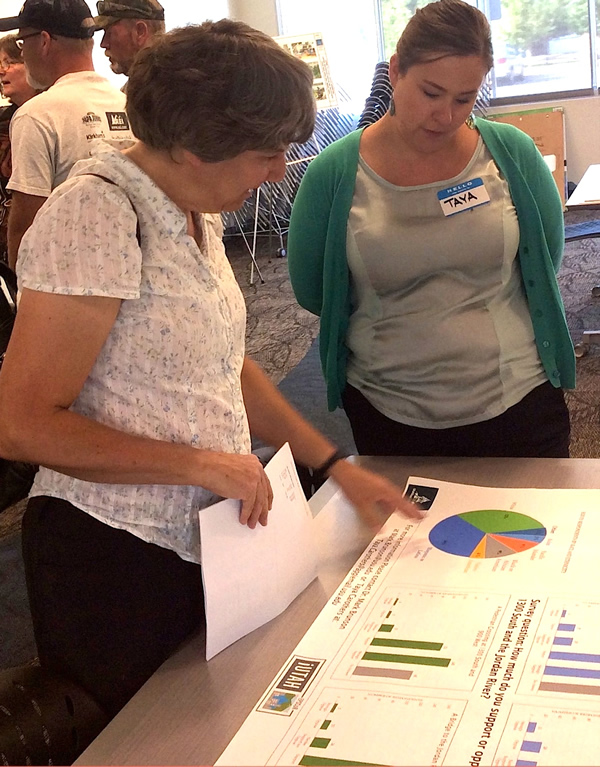
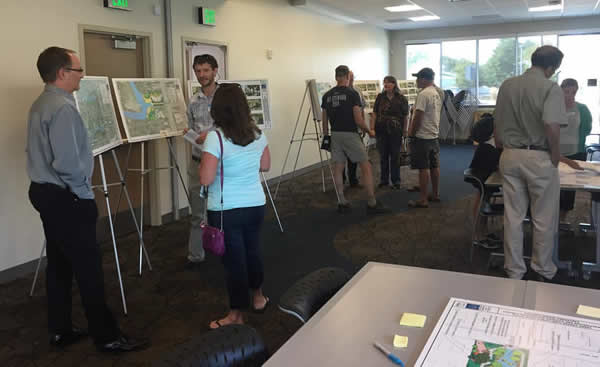
October 28, 2016
Students Present Research at National Diversity Conference
Two iUTAH students, Joydino Beyale and Luis Vidal, were among the many undergraduate students presenting research at the Society for the Advancement of Chicanos/Hispanics and Native Americans in Science (SACNAS) National Conference for Diversity in STEM in Long Beach, CA, on October 13-15, 2016.
Research for their presentations at SACNAS started last summer, when the two students were accepted into the iUTAH iFellows undergraduate research experience. This 11-week program culminated in the creation of a formal presentation and paper on the topics listed below.
- Joydino Beyale, USU Eastern in Blanding, presented on Determining the Quantity and Quality of Rainwater Drainage from Various Rooftops
- Luis Vidal, University of Utah, presented on Cross Cutting Relationships Among Community Concerns and Green Urban Infrastructure in the Jordan River Corridor
Ellen Eiriksson, iUTAH Education, Outreach and Diversity Coordinator, said “iUTAH is proud to not only provide research opportunities for undergraduate students from across Utah, but also support students in sharing their research at relevant conferences”
“It was a little intimidating at first with so many people” said Vidal, a junior studying Geology and Environmental Science at the University of Utah. “There was a great sense of inclusion in the conference and being around other students with similar backgrounds, especially when meeting other earth scientists of similar backgrounds.”
For Beyale, who is finishing his general studies at Utah State University Eastern in Blanding and plans to major in Environmental Engineering, the best part was the “many workshops and people to talk to, “ adding “being part of SACNAS has opened up a whole new beginning for me.”
While time was tight at the conference, which had record turnout with more than 4,000 attendees, and 1,000 student research presenters, students found opportunities to learn about graduate schools and internships, meet faculty and students from schools throughout the U.S., and get information about key resources and programs. The 2017 SACNAS National Conference will be held on October 19-21, 2017 in Salt Lake City, Utah, providing more Utah students and researchers a chance to attend.
“Both Luis and Joydino's iFellows research allowed them to connect with a wide audience” said Eiriksson. “Their iUTAH faculty mentors helped the students develop skills to share this research on a national scale, and we hope they now feel empowered to use this research and skills to positively impact their communities.”
When asked what advice they would give to other students interested in going to undergraduate conferences, Beyale said “work hard, get involve with your college, and most importantly be connected with your mentors and professors.”
Press: Utah State Today | UU News
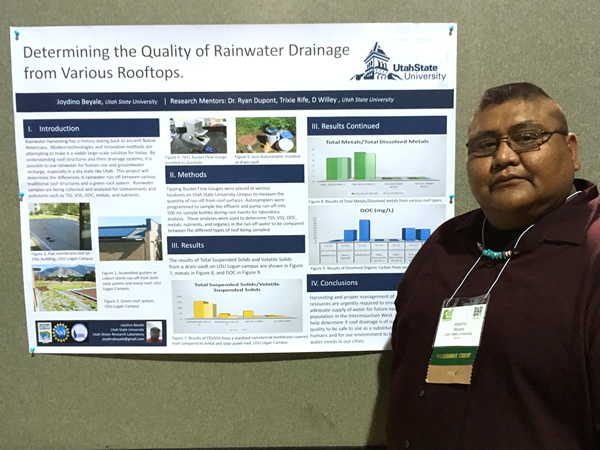
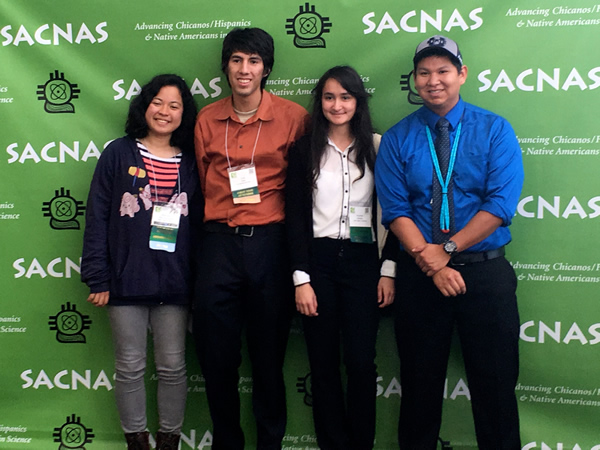
August 3, 2016
Just Add Water: iUTAH's Summer Institute Engages Students and Teachers

As the fourth and final year of the iUTAH Summer Research Institute came to a close in July 2016, students, teachers, and faculty members reflected on the impact the program has had on them. Among the articles written about the weeklong program, the U’s article said that “A week of hands-on science projects changed the way Jose Galang, a junior at Juan Diego High School in Draper, thought about science. ‘I used to think that scientists were really smart people just doing research and experiments by themselves,’ he said. ‘I never realized there were so many people working together to solve problems.’ ”
Galang was among nine high school students who participated in the National Science Foundation funded-iUTAH summer research institute July 11-15, 2016. The institute brought together high school students, secondary education teachers and undergraduate students to conduct research on water sustainability in Utah under the direction of faculty, postdocs and graduate students from universities across the state.
The group got a firsthand look at what research looks like in several disciplines. On the first day, they recorded observations about the conditions along Emigration Creek and collected water samples. The second day, they learned how to trace the origin of fruits and vegetables by analyzing isotopes in the water content. The third day, they divided into groups across the valley and conducted social science research by surveying people about their access to water. The week culminated in a poster session, where participants presented their work and findings.
‘This program provides a really unique opportunity to bring together students and educators from all along the STEM pipeline,’ said Louisa Stark, director of the iUTAH Summer Research Institute and U professor. ‘There was a lot of peer mentoring going on between the high school students and undergraduates and among the secondary education teachers and the university faculty.’ ”
The article includes comments by other students and Rachel Gabor, iUTAH postdoctoral researcher, and can be read in its entirely below.
Press: UU News | Deseret News | KUSU Radio
July 26, 2016
Farming Without Soil: U Student's Hydroponics Research Among 18 Projects Showcased
iUTAH iFellows Undergraduate Research program and its participants were featured in a University of Utah news story. As the 11-week program concludes this week, students such as Georgie Corkey reflect on what they have learned.
The U’s article said “For the last 10 weeks, University of Utah student Georgie Corkery has investigated sustainable urban farming options for Salt Lake, and she will present her work at a symposium Wednesday, July 27, at the University of Utah Guest House, 110 S. Fort Douglas Boulevard, 9 a.m.-3 p.m. Corkery is among 18 undergraduate students from universities across the state who were accepted to work as iFellows, a program designed to connect undergraduate students with faculty researchers whose work is part of the National Science Foundation funded-iUTAH project. iUTAH, which stands for innovative urban transitions and arid-region hydro-sustainability, is an interdisciplinary research and training program aimed at strengthening science for Utah’s water future. Part of that involves outreach projects that train the next generation of water scientists.”


June 14, 2016
18 Undergraduates Receive Support to Conduct Research This Summer
iUTAH is working hard to address Utah’s need to help students grow their interest in STEM research fields. Through its iFellows program, undergraduate students are involved in cutting-edge research and scholarly work on water-related issues. This program, now in its fourth year, takes place over an 11-week period each summer, beginning in May. Since 2013, the program has funded 63 iFellows undergraduate researchers, bringing students from around the state to Utah’s premier research institutions: the University of Utah, Utah State University, and Brigham Young University.
One of the best parts of the iFellows program is that it stimulates interest among talented undergraduates in research science careers by introducing them to the work researchers are doing. Students are involved in a wide range of research topics, ranging from aquatic biology to urban planning to environmental engineering. A key component of the program is identifying and matching student interests to research projects and mentors. Once they are assigned to a faculty member, graduate and peer mentor, students become involved in current iUTAH research projects.
This year’s 18 iFellows represent iUTAH’s continuing commitment to STEM education and diversity with 71% female and 18% under-represented minority students participating. The 2016 iFellow undergraduate researchers are listed as follows, including hometown, current institution, and iUTAH faculty mentor:
- Joydino Beyale - Red Mesa, UT, USU Eastern – Blanding, with Ryan Dupont, USU
- Heather Bottelberghe - Grantsville, UT, Salt Lake Community College, with Sarah Null, USU
- Katelyn Boyer – Springville, UT, Utah State University, with Sam St. Clair, BYU
- Todd Brown – Hooper, UT, Utah State University, with David Rosenberg, USU
- Darcie Christensen – Tremonton, UT, Utah State University, with Christine Pomeroy, UU
- Georgie Corkery – Salt Lake City, UT, University of Utah, with Steve Burian, UU
- Cynthia Elliott – Valencia, CA, Weber State University, with Mark Brunson, USU
- Andrew Hackett – Layton, UT, Weber State University, with Sarah Null, USU
- Greta Hamilton – Salt Lake City, UT, Salt Lake Community College, with Greg Carling, BYU
- Stacy Henderson – Salt Lake City, UT, Westminster College, with Joanna Endter-Wada, USU
- Rebecca Lee – San Diego, CA, Brigham Young University, with Zach Aanderud, BYU
- Gabriela Martinez – Salt Lake City, UT, Salt Lake Community College, with Sarah Hinners, UU
- Mitchell Steele – Orem, UT, Utah State University, with Ryan Dupont, USU
- Shanae Tate – Salt Lake City, UT, Brigham Young University, with Scott Jones, USU
- Luis Vidal – Logan, UT, University of Utah, with Mark Brunson, USU
- Lily Wetterlin – Midway, UT, University of Utah, with Diane Pataki, UU
- Adam Whalen – Draper, UT, University of Utah, with Sara Yeo, UU
- Sandra Udy (Young) – Vernal, UT, Utah State University, with Michelle Baker, USU
“This summer’s iFellows Program is off to a great start,” says Ellen Eiriksson, iUTAH Education, Outreach and Diversity Coordinator. “Students have arrived eager to contribute to iUTAH's multi-disciplinary research and to gain valuable experience working with the project's many inspirational faculty and near-peer mentors.” These students come from disciplines ranging from general studies and communications to environmental science and engineering. All are bringing new ideas and insights together to help address Utah’s future water concerns.
